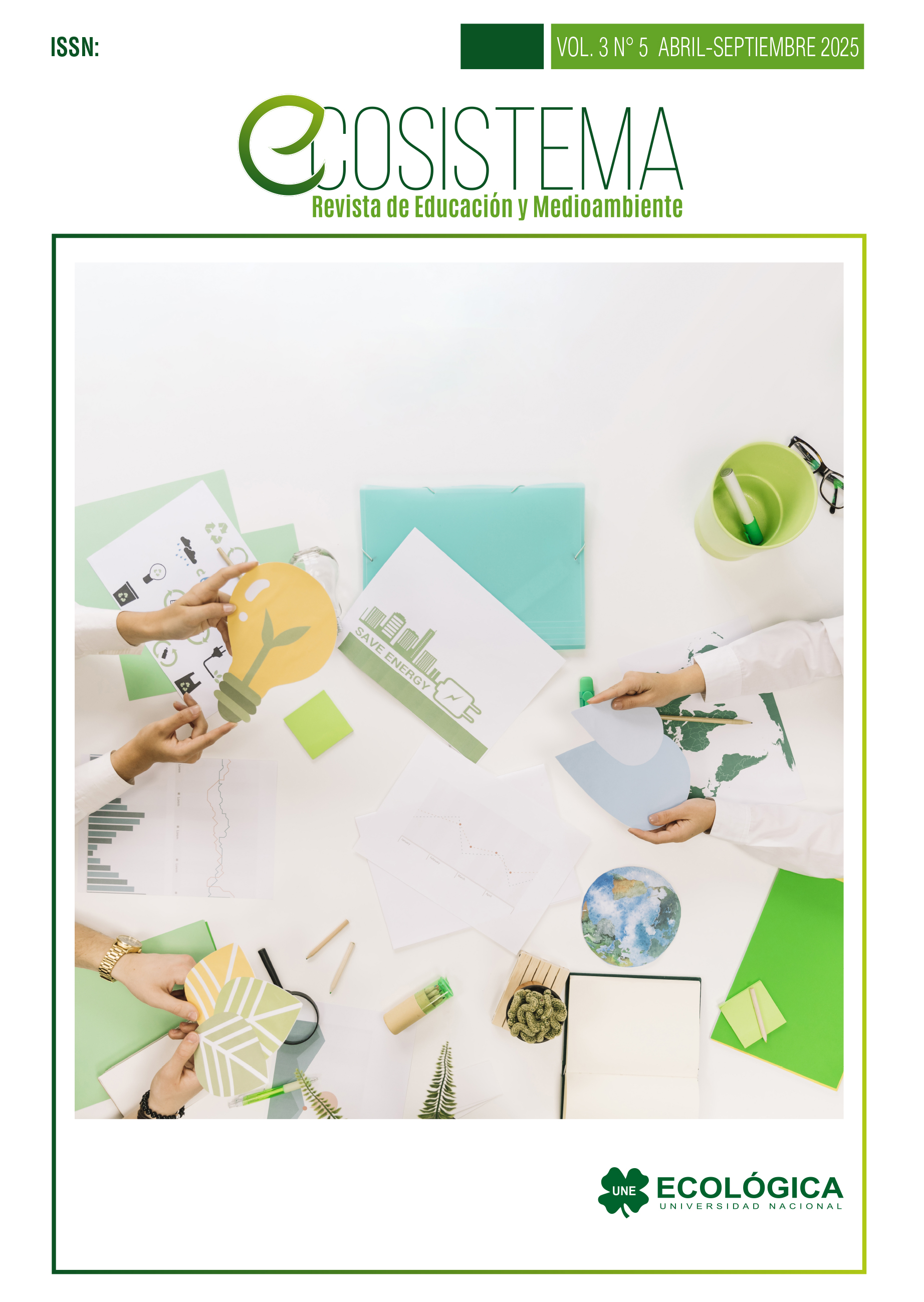Material de reciclaje y la producción de textos con menores de 5 años Recycling materials and text production with children under 5 years of age
Contenido principal del artículo
La presente investigación tuvo como objetivo determinar la relación entre el uso de material de reciclaje y la producción de textos en niños de 5 años de la Institución Educativa Sagrado Corazón de Jesús de Jicamarca durante el año 2023. El estudio empleó un enfoque cuantitativo con diseño correlacional de corte transeccional, trabajando con una población y muestra censal de 35 estudiantes. Los instrumentos utilizados fueron listas de cotejo para evaluar ambas variables, validadas por juicio de expertos y con alta confiabilidad (?=0.809 y ?=0.904 respectivamente). Los resultados revelaron una correlación extremadamente positiva y estadísticamente significativa (R=0.969, p<0.05) entre el material de reciclaje y la producción de textos. El análisis por dimensiones mostró correlaciones significativas en planificación (R=0.901), textualización (R=0.728), revisión (R=0.680) y redacción final (R=0.486). Se concluye que existe una relación significativa y positiva entre ambas variables, confirmando que el material de reciclaje potencia el desarrollo de habilidades de producción textual en educación inicial.
This research aimed to determine the relationship between the use of recycled materials and text production among 5-year-old children at the Sagrado Corazón de Jesús Educational Institution in Jicamarca during the year 2023. The study employed a quantitative approach with a cross-sectional correlational design, working with a population and census sample of 35 students. The instruments used were checklists to assess both variables, validated by expert judgment and with high reliability (? = 0.809 and ? = 0.904, respectively). The results revealed an extremely positive and statistically significant correlation (R = 0.969, p < 0.05) between recycled materials and text production. The analysis by dimension showed significant correlations in planning (R = 0.901), textualization (R = 0.728), revision (R = 0.680), and final writing (R = 0.486). It is concluded that there is a significant and positive relationship between both variables, confirming that recycling materials enhance the development of text production skills in early childhood education.
Detalles del artículo

Esta obra está bajo una licencia internacional Creative Commons Atribución-NoComercial-CompartirIgual 4.0.
Referencias
Ardoin, N., y Bowers, A. (2020). Early childhood environmental education: A systematic review of the research literature. Educational Research Review, 31, 100353. https://doi.org/10.1016/j.edurev.2020.100353
Arreguín, M. (2021). Environmental Education for Toddlers and Their Caretakers as a Context for Language Development: Opportunities and Challenges. International Journal of Early Childhood Environmental Education, 9(1). [Fuente: ERIC EJ1298026]
Borg, F., Gericke, N., Ohlsson, A., y Granberg, U. (2024). Education for sustainability in preschool: Swedish preschool teachers’ perspectives. Cogent Education, 11(1), 2353477. https://doi.org/10.1080/2331186X.2024.2353477
Dere, Z. (2019). Investigating the Creativity of Children in Early Childhood Education Institutions. Universal Journal of Educational Research, 7(3), 652-658. https://doi.org/10.13189/ujer.2019.070302
Duncan, L., Gollek, C., y Potter, D. (2020). eLIPS: Development and Validation of an Observational Tool for Examining Early Language in Play Settings. Frontiers in Psychology, 11, 1813. https://doi.org/10.3389/fpsyg.2020.01813
Esmaeeli, S. (2023). A Model of the Home Literacy Environment and Family Risk of Reading Difficulty in Relation to Children’s Preschool Emergent Literacy. Journal of Learning Disabilities, 56(6), 456-472. https://doi.org/10.1177/00222194231195623
Fortino, C., Gerretson, H., Button, L., y Masters, V. (2014). Growing Up WILD: Teaching Environmental Education in Early Childhood. International Journal of Early Childhood Environmental Education, 2(1), 21-38. [Fuente: ERIC EJ1108027]
Gómez, J. (2014). Estrategias para la promoción del reciclaje en contextos urbanos. Editorial Académica.
González Orozco, L. (2017). Reutilización de materiales en educación ambiental: perspectivas pedagógicas. Universidad Pedagógica Nacional.
Justiniano, R. (2020). Programa de gestión de residuos sólidos para el desarrollo de conciencia ambiental [Tesis de maestría]. Universidad Nacional de Educación.
Kahriman, D., y Pramling, I. (2024). Nurturing Sustainability in Toddlerhood: Investigating Preschool Teachers’ Views and Daily Practices in a Swedish Preschool. Children, 11(12), 1412. https://doi.org/10.3390/children11121412
Ministerio de Educación. (2016). Currículo Nacional de la Educación Básica. MINEDU. https://www.minedu.gob.pe/curriculo/pdf/curriculo-nacional-de-la-educacion-basica.pdf
Ohlsson, A., Gericke, N., y Borg, F. (2024). Implementing education for sustainability in preschool: Teaching strategies and learning environments. Journal of Outdoor and Environmental Education, 27(2). https://doi.org/10.1007/s42322-024-00181-5
Prado, M. (2019). Producción de textos desde el enfoque comunicativo textual en niños menores de 4 años [Tesis de licenciatura]. Universidad Nacional de Educación.
Rodríguez, C., Jiménez, J., y Balade, J. (2024). The Impact of Oral Language and Transcription Skills on Early Writing Production in Kindergarteners: Productivity and Quality. Early Childhood Education Journal, 52(4). https://doi.org/10.1007/s10643-024-01670-4
Tuğba A. y Yabas, D. (2025). Seeding sustainable futures: enhancing children’s knowledge of content and skills through early STEM education. Environmental Education Research, 31(3), 324-341. DOI:10.1080/13504622.2025.2465722
Theodotou, E. (2021). Evaluating storytelling activities for early literacy development. International Journal of Early Years Education, 30(4), 580-595. https://doi.org/10.1080/09669760.2021.1933917
Theodotou, E. (2025). Literacy development through the arts in early childhood education. International Journal of Early Years Education, 31(2), 198-215. 2025, VOL. 45, NO. 2, 242–255 https://doi.org/10.1080/09575146.2024.2343712


